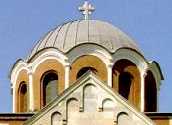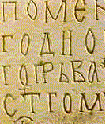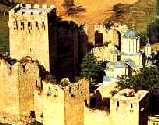|
|
The only travel service introducing you to Belgrade & Serbia with care and affection!
Monastery Tour of Serbia (2 days) |
|||||||||||||||||||

|

|

|

|
||||||||||||||||
|
Intriguing beauty: a detail from Studenica |
Unique experience: Messages from the past |
Mighty isolation: |
|||||||||||||||||
The medieval splendor of Serbia! |
|||||||||||||||||||
|
Blessed is he who comes in the name of the Lord.
Ravanica monastery (founded by the Serbian Prince Lazar in the second half of the 14th century) is the most typical example of what is called the Morava school of Serbian medieval architecture. The monastery's five-domed Church of the Ascension displays rather badly damaged but very fine frescoes. A transparent coffin containing relics of the great and highly devoted Prince Lazar, killed in the battle of Kosovo in 1389 and soon afterwards declared saint, is now displayed in this church (the relics can be seen only on Sundays). Lazarica Court Church (founded by the Serbian Prince Lazar around 1380) represents a fine architectural achievement adorned with rich carved stone decoration on the arches, rosettes, windows and portals. It is situated in the town of Krusevac, once the capital of the Lazar's state. As one of the earliest monuments of the Morava school it long served as a model for Serbian builders. Studenica monastery (founded by Stefan Nemanja, who took monastic orders there choosing the name Simeon) is considered to be the crowning achievement of medieval culture and art in Serbia. The monastic complex consists of the fascinating Church of the Virgin (1183-1196), the Church of SS Joachim and Anne (also known as the King's Church) and the Church of St. Nicholas, a simple single-nave building. The monastery circle contains monuments raised over a period of 130 years and several Serbian rulers had a hand in their construction. At the start of this period, the young Serbian feudal state under Nemanja was consolidating its independence, and by Milutin's reign it had reached the height of its political, cultural and economic power. The strengthening of the medieval state and of its ruler's might is naturally reflected in these monuments. Zica monastery (founded by the Serbian King Stefan "the First-Crowned" at the beginning of the 13th century) is of great historical importance. The Church of the Ascension served as the first see of the independent Serbian Archbishopric and played a very important role in the religious, political and cultural life of mediaeval Serbia. In its basic features, the architecture of Zica, which has undergone considerable changes, belongs to the oldest school of Serbian medieval architecture. The interior fresco decoration dates from various periods. Ljubostinja monastery (founded by Prince Lazar's wife, Princess Milica in 1388) with its Church of the Dormition of the Virgin is considered to be one of the most elegant architectonic monuments of mediaeval Serbia: the domed building, situated in a very pleasant environment, displays the form of an inscribed cross combined with a trefoil. This is maybe the only Serbian monastery where the names of both the chief builder and painter have been preserved.
|
Please note:
|
| |||||||||||||||||
|
If you have
accessed this page outside a frame, please follow this link to the frames
version:
|
BELGRADE
SIGHTSEEING / BRANKO RABOTIC, MA
Phone/fax: (++38111) 446.11.53, GSM: (++38163) 854.26.48
(Calls to GSM from inside Serbia: 063 854.26.48)
E mail: rabotic@EUnet.yu URL:
http://rabotic.tripod.com/